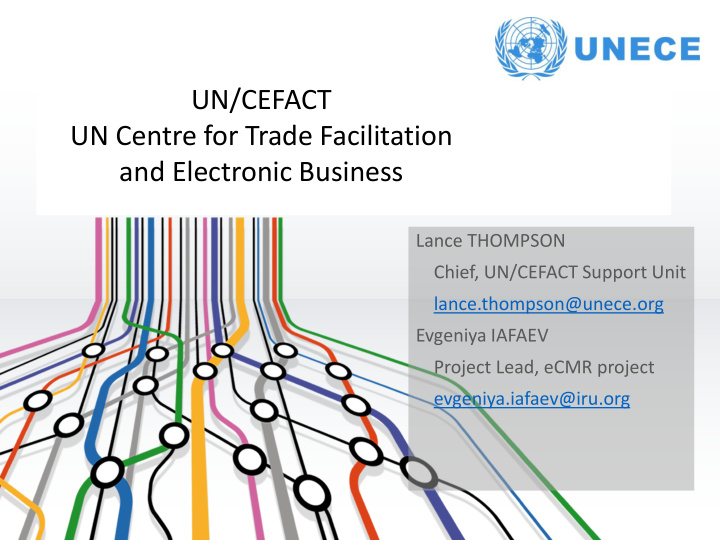



UN/CEFACT DGMOVE DTLF Meeting UN Centre for Trade Facilitation Brussels and Electronic Business 26 April 2017 Lance THOMPSON Chief, UN/CEFACT Support Unit lance.thompson@unece.org Evgeniya IAFAEV Project Lead, eCMR project evgeniya.iafaev@iru.org
UN/CEFACT Mission Objectives • Simple, transparent and effective UN processes for global business • Efficient and automated exchange of information UN/ECOSOC Outputs • Global Trade Facilitation and Electronic Business UN/ECE Recommendations and Standards Means • Public Private Sector Partnership – over 300 experts from government UN/CEFACT and business • Meet virtually every week plus two Global Remit Forums per year 2
Buy – Ship – Pay (BSP) Model PAY BUY SHIP Prepare for Export Transport Prepare for Import Export Import INVOLVES Commercial Transport Regulatory Procedures Financial Procedures Procedures Procedures • Obtain Import/Export • Provide Credit • Establish Contract • Establish Transport Licences etc Rating • Order Goods • Provide Customs • Provide Insurance Contract • Advise On Delivery • Collect, Transport • Provide Finance Declarations • Request Payment • Provide Cargo • Execute Payment and Deliver Goods • Packing • Provide Waybills, • Issue Statements Declaration • Inspection • Apply Trade Security Goods Receipts • Certification Status reports etc. Procedures • Accreditation • Clear Goods for • Warehousing Export/Import
UN/CEFACT & Trade Facilitation TRADE FACILITATION Simplification Process of eliminating all unnecessary elements and duplications in formalities, processes and procedures Harmonization Alignment of national procedures, operations and documents with international conventions, standards and practices Standardization Process of developing internationally agreed formats for practices and procedures, documents and information
UN/CEFACT Key Deliverables • Over 30 Trade Facilitation Recommendations • Recommendation 1 – UN Layout Key for Trade Documents • Recommendation 4 – National Trade Facilitation Bodies • Recommendation 33 – Single Window • Code List Recommendations • Recommendation 16 – UN/LOCODE • Recommendation 21 – Package Codes • Recommendation 28 – Means of Transport • International Standards • UN/EDIFACT (directories, code lists, etc.) • Supply Chain Reference Data Model • Business Requirement Specifications
http://tfig.unece.org/
DGMOVE DTLF Meeting UN/CEFACT e-CMR Project Brussels 26 April 2017 Evgeniya IAFAEV Project Leader
Table of contents • UN/CEFACT e-CMR project and its deliverables • Project status • e-CMR project focus • e-CMR model (work in progress)
Challenge: Interoperability of e-CMR solutions • Content of CMR • Date and time CMR • Name and address of carrier, sender, consignee •The description of nature of goods, method of packing … Convention • Number of packages • Charges related to carriage • etc. • Set requirements for e-CMR. Parties shall agree on: e-CMR • The method for issuance and delivery of e-CMR • An assurance that e-CMR retains its integrity Additional • The manner in which the party entitled to the rights arising out of e-CMR Protocol is able to demonstrate that entitlement • etc. First step: identify a list of vital messages for e-CMR, provide appropriate message model
UN/CEFACT e-CMR project deliverables e-CMR project deliverables: • Business Requirements Specification (BRS) for Electronic Road Consignment Note (e-CMR) based on the high-level MMT BRS • Subset exchange syntax-neutral message structures for e-CMR • XML schemas of the e-CMR messages • Mapping to the relevant existing UN/EDIFACT UNSM (IFTMIN) e-CMR project supported by: Project Team: • Project leader: Evgeniya Iafaev, • Lead Editor: Rudy Hemeleers • Editor: Bérengère Coupet Maisonnave • Experts: • Thierry Grumiaux • Gianguglielmo Calvi • Sue Probert plus others
Current Project Status • Draft e-CMR message model – work in progress Goal: Public Review launch by October 2017 • Business Requirements Specification public review completed Results of the Public Review are under revision
UN/CEFACT e-CMR project focus Transport Sender Consignee Carrier Service Buyer (Consignor) (Sender, Consignor, Consignee) 1. Consignment Instructions 2. Issue of e-CMR and hands over of goods to carrier e-CMR 3. Proof of Delivery 4. Status 4. Status 4. Status * Changes based on BRS review
e-CMR model Transport Sender Service Buyer (Consignor) (Sender, Consignor, Consignee) 1. Consignment Instructions draft • Parties details (consignor, consignee, carrier etc) • Included Consignment Items • Acceptance / Delivery locations • Etc
e-CMR model Sender Carrier (Consignor) 2. Issue of e-CMR and hands over of goods to carrier evidence of contract existence • Parties details (consignor, consignee, carrier etc) • Included Consignment Items • Acceptance / Delivery locations • etc • Carrier pickup event (Parties certification, used transport equipment, observations)
e-CMR model A B C A B C
e-CMR model (contractual events) A B C A B C
e-CMR model: Transit Declaration model of NCTS and of Eurasian Customs Union are taken into account
e-CMR model: CMR Convention requirements taken into account Each object in the eCMR structure has a unique Dictionary Entry Name plus a business short name for readability. Based upon the UN/CEFACT Core Component Library (CCL), the MultiModal Transport Reference Data Model (MMT) and the Supply Chain Reference Data Model (SCRDM).
For more information Project Leader • Evgeniya Iafaev (Evgeniya.Iafaev@iru.org) UN/CEFACT responsible Vice Chair • Sue Probert (sue.probert@dial.pipex.com) UNECE secretariat • Lance Thompson (lance.thompson@unece.org) • www.unece.org/cefact
Recommend
More recommend